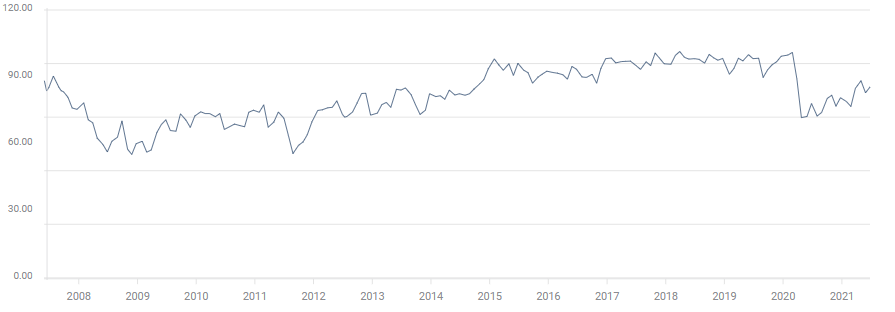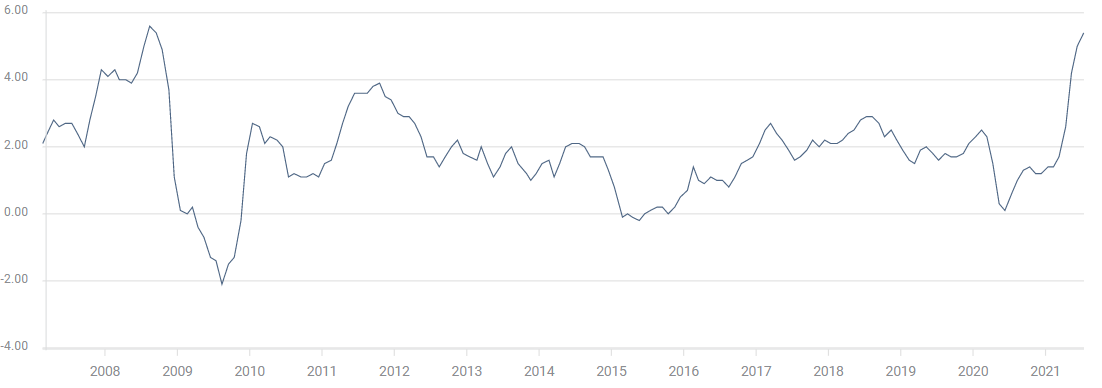- The Fed is watching jobs, is the consumer watching inflation?
- Outsize price gains likely to continue for the rest of the year.
- Real hourly wages drop in June, overwhelmed by inflation.
- Markets could see a fall in sentiment as a warning on US rates.
After a year of emotional partnership, the Federal Reserve and the American consumer may have suddenly parted ways.
“There is still a long way to go” before the bank will change its ultra-accommodative monetary policy, said Fed Chair Jerome Powell in remarks prepared for Congressional testimony on Wednesday. He noted that the labor market was still far from its pre-pandemic employment.
But with jobs going begging across the country, there were a record 9.2 million unfilled positions in May, and help-wanted signs as common as weeds in a summer lawn, it should be clear, even to the Fed, that any American who wants work can find it by going around the corner.
Michigan Consumer Sentiment
The Michigan Consumer Sentiment Index is forecast to rise slightly in July to 86.5 from 85.5 in June. In February 2020 the index scored 101. Two months later in April it had plunged to 71.8. Since that low the highest has been 88.3 this past April. The six-month average is 82.9.
Michigan Consumer Sentiment
Consumer sentiment and inflation
Consumer sentiment is most closely tied to employment but inflation runs a close second. Constant price increases are probably the most discouraging economic condition for most families short of an inability to find work.
The reason is simple. Wage increases may come once or twice a year and they are hardly automatic. Inflation is inexorable. Rising prices take a larger bite of the family budget every time they go to the supermarket.
CPI and real wages
For working Americans, soaring inflation is undermining wages gains and quickly becoming the greatest threat to their economic well-being.
While the Fed may target the core inflation rate, eschewing energy and food prices, families cannot do so. For most Americans, what matters, and what influences their inflation expectations, are the goods and services they actually buy.
Consumer prices jumped 5.4% in June. It was the highest annual increase in 13 years.
CPI
The acceleration in prices has been astonishing. Over 12 months the CPI average is 2.3%, over six it’s 3.4% and over three months, the moving average is 4.9%.
Core inflation has climbed from 2.1% for 12 months, to 2.6% for the half-year, to 3.8% for the quarter.
Real average hourly earnings fell 0.6% in June, the 0.3% gain in payments negated by the 0.9% drop in purchasing power. If you take the annual figures it is a 1.8% decline over the past year, the 3.6% increase in hourly wages subsumed by a 5.4% jump in prices.
Some items that become more expensive have cheaper substitutes or can be skipped without much change in lifestyle.
One consumer staple has no substitute, gasoline. For most Americans, driving is what economists call an inflexible good. That means as the prices rise consumption does not diminish very much.
Gasoline rose 2.5% in June and the price of a gallon of regular fuel has skyrocketed 45.1% in a year. It now costs almost 50% more to fill a car's gas tank than it did in August 2020.
Inflation is a direct drain on consumer resources. There is no way for a family to counteract price increases, they can only be absorbed. Hence, its direct impact on consumer sentiment.
Federal Reserve policy
The Fed’s new mantras, “substantial further progress” and inflation averaging, which permit prices to run hotter and longer, risk changing inflation expectations for consumers and businesses.
Chairman Powell has repeatedly asserted that recent inflation is temporary, due to lockdown created shortages of material and components, and that increases will eventually wane. However, there are signs that the sources of current inflation, from commodity and oil pricing to wage gains and supply and production dislocations, are more entrenched than economists have assumed. In his Congressional testimony this week, Mr. Powell acknowledged that price increases have been higher and will last longer than originally anticipated by the central bank.
The Fed’s June Projection Materials increased the 2021 inflation estimate from 2.4% to 3.4%. Given the rates of the past three months, that probably understates the final result.
When the Fed instituted its new averaging policy last September, the governors were probably not envisioning months or a year of 4% and 5% increases. If the policy was designed to obtain the 2% core inflation target it is already successful. The 12-month CPI average is 2.3%, the core is 2.1%.
Inflation expectations may have already begun to shift. Many businesses have been forced to offer bonuses and wage increases in order to find workers. When those workers go shopping for cars, food or home improvement products, among many others, they find those wage gains already absorbed by price increases.
If the Fed’s focus on unemployment and returning the labor market to its 2019 fullness means that rates and the bond purchase program will remain unchanged until the end of the year and beyond, each month of high inflation without policy action reinforces the expectation that it will continue.
Conclusion: Sentiment and markets
Tuesday’s June CPI release, cited above, had pushed Treasury yields higher. The 10-year rose 5 basis points and the 2-year added 2 points. Those gains were reversed on Wednesday and Thursday by Chairman Powell’s insistence that the Fed’s accommodative policy will remain in place for the immediate future.
It may take several months for consumer confidence to be substantially damaged by inflation. But if price increases continue at the present rate until the end of the year, it is almost a certainty they will erode sentiment.
Markets do not usually trade sentiment numbers, preferring the hard figures of Retail Sales, which will be reported for June this Friday.
However, if the June Michigan sentiment number is weaker than expected, the likely cause will be inflation.
The economy is producing a large number of jobs. Employment is readily available in most fields, even if employees seem somewhat reluctant to return to work.
Poor consumer sentiment readings could be an early warning sign of shifting inflation expectations.
Federal Reserve monetary policy has a long lead time against inflation. That is not true for inflationary expectations. The more tolerant the Fed is of inflation, the more consumers will expect price increases to continue.
.
Information on these pages contains forward-looking statements that involve risks and uncertainties. Markets and instruments profiled on this page are for informational purposes only and should not in any way come across as a recommendation to buy or sell in these assets. You should do your own thorough research before making any investment decisions. FXStreet does not in any way guarantee that this information is free from mistakes, errors, or material misstatements. It also does not guarantee that this information is of a timely nature. Investing in Open Markets involves a great deal of risk, including the loss of all or a portion of your investment, as well as emotional distress. All risks, losses and costs associated with investing, including total loss of principal, are your responsibility. The views and opinions expressed in this article are those of the authors and do not necessarily reflect the official policy or position of FXStreet nor its advertisers. The author will not be held responsible for information that is found at the end of links posted on this page.
If not otherwise explicitly mentioned in the body of the article, at the time of writing, the author has no position in any stock mentioned in this article and no business relationship with any company mentioned. The author has not received compensation for writing this article, other than from FXStreet.
FXStreet and the author do not provide personalized recommendations. The author makes no representations as to the accuracy, completeness, or suitability of this information. FXStreet and the author will not be liable for any errors, omissions or any losses, injuries or damages arising from this information and its display or use. Errors and omissions excepted.
The author and FXStreet are not registered investment advisors and nothing in this article is intended to be investment advice.
Recommended Content
Editors’ Picks

EUR/USD holds above 1.0400 in quiet trading
EUR/USD trades in positive territory above 1.0400 in the American session on Friday. The absence of fundamental drivers and thin trading conditions on the holiday-shortened week make it difficult for the pair to gather directional momentum.

GBP/USD recovers above 1.2550 following earlier decline
GBP/USD regains its traction and trades above 1.2550 after declining toward 1.2500 earlier in the day. Nevertheless, the cautious market mood limits the pair's upside as trading volumes remain low following the Christmas break.

Gold declines below $2,620, erases weekly gains
Gold edges lower in the second half of the day and trades below $2,620, looking to end the week marginally lower. Although the cautious market mood helps XAU/USD hold its ground, growing expectations for a less-dovish Fed policy outlook caps the pair's upside.

Bitcoin misses Santa rally even as on-chain metrics show signs of price recovery
Bitcoin (BTC) price hovers around $97,000 on Friday, erasing most of the gains from earlier this week, as the largest cryptocurrency missed the so-called Santa Claus rally, the increase in prices prior to and immediately following Christmas Day.

2025 outlook: What is next for developed economies and currencies?
As the door closes in 2024, and while the year feels like it has passed in the blink of an eye, a lot has happened. If I had to summarise it all in four words, it would be: ‘a year of surprises’.

Best Forex Brokers with Low Spreads
VERIFIED Low spreads are crucial for reducing trading costs. Explore top Forex brokers offering competitive spreads and high leverage. Compare options for EUR/USD, GBP/USD, USD/JPY, and Gold.

